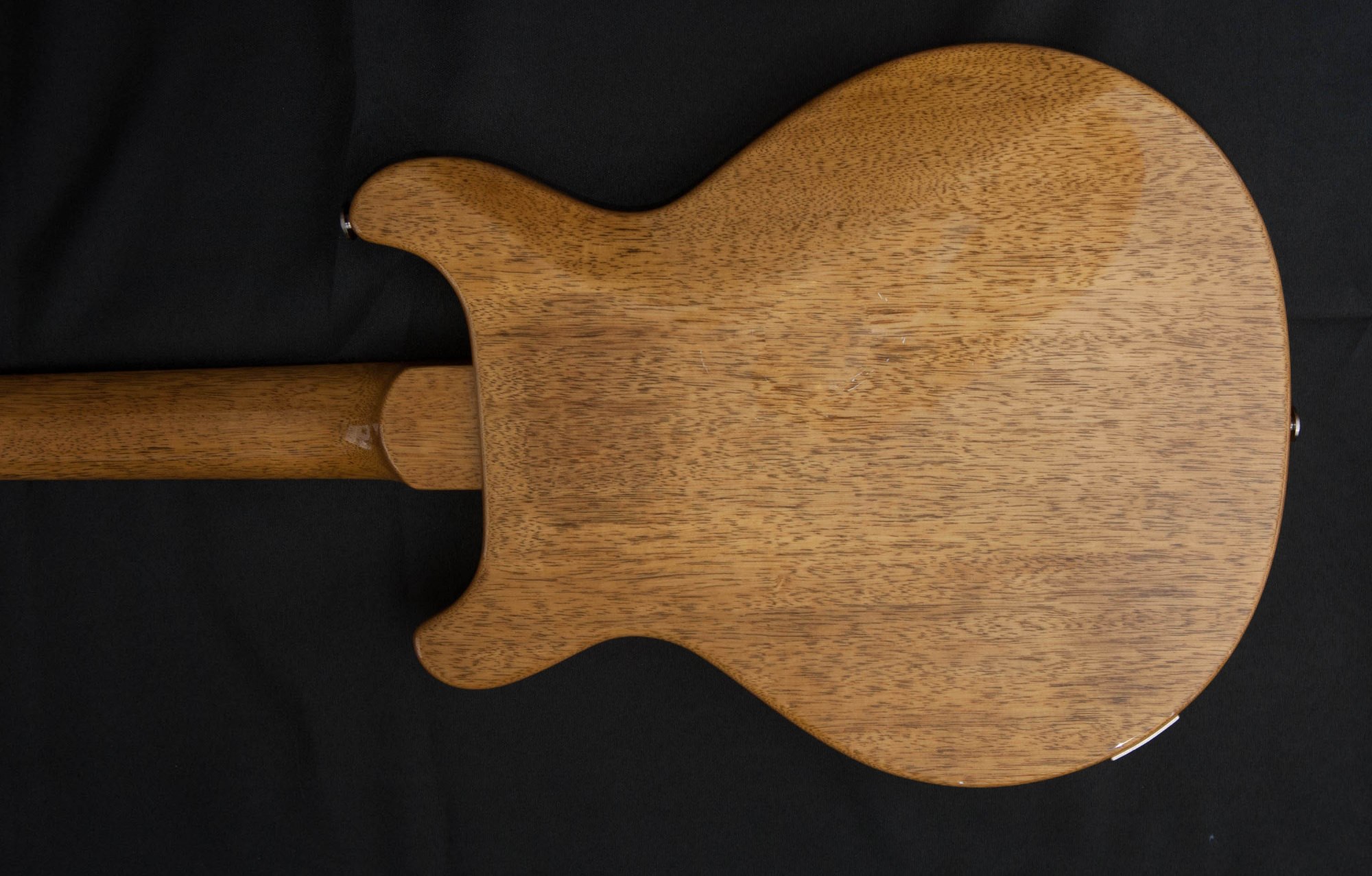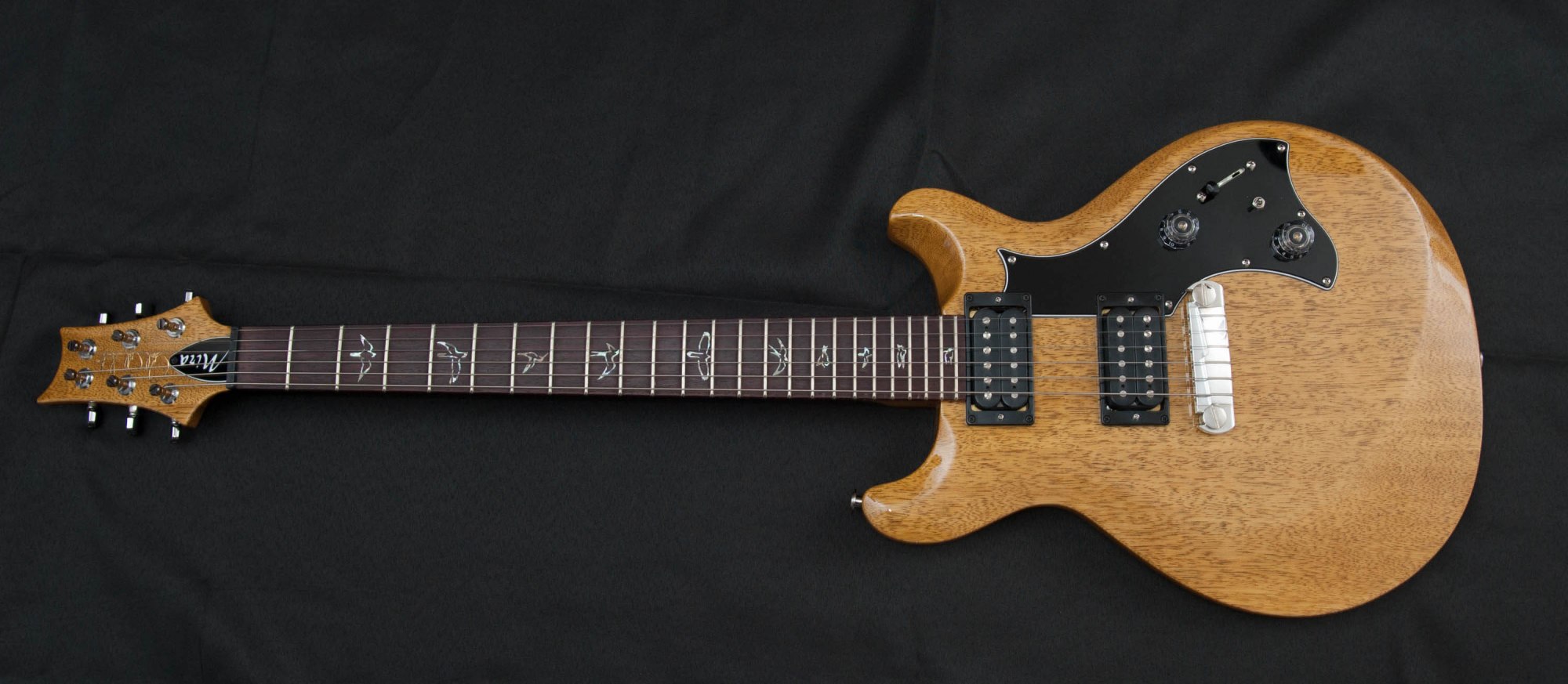Paul Reed Smith Korina Mira
 Year: 2009
Year: 2009
Finish: Natural korina
Origin: USA
Mods: None
Acquired: 2012
Still owned: No
The Story:
I have had this sad, sick obsession with korina for years. Korina — African limba, or terminalia superba if you want to get really technical — is what Gibson used on its Flying V and Explorer guitars in the 1950s, and since those are rare, the wood has taken on a mythical quality. It actually sounds a bit like mahogany, but with more midrange — and I love midrange in guitar tones. I bought a korina Epiphone Explorer in the mid-90s which sounded awesome, but then I had an attack of buyer’s remorse and returned it after three days — so brief, I didn’t even include it on this website. In retrospect, maybe I should have kept it.
Ever since, I’ve been on the hunt for korina. I seriously considered the Epiphone Moderne from 2000 (the shape of which Kat hates, so I never pulled the trigger) and I considered putting together my own korina “Amricaster” from Warmoth parts, but when I heard Paul Reed Smith was making korina guitars as part of the import SE line, suddenly I had my answer. That was…until I played one. It had the sound, but the neck was the wide-fat shape that PRS fans so adore. I can barely get my hands around it; I cannot play comfortably with that shape. Even the PRS “Pattern Regular” neck is awkward, so that leaves the “wide-thin” shape as my only option. I played a wide-thin PRS and it felt pretty good…but they don’t make korina SEs with wide-thin necks, and they don’t make wide-thin PRS guitars out of korina. You can’t get there from here. You lose.
Not quite. I found out that in 2009, PRS created a limited run of its main instruments in korina, including the Mira. Now, the Mira is a fun little beast — it’s PRS’s take on Gibson’s Les Paul Junior Doublecut with a little bit of SG thrown in. I’ve always wanted an SG but heard too many horror stories about broken headstocks to actually commit to one. Meanwhile, the Mira is the product of modern engineering, with a more stable but still set-neck construction, locking tuners, and coil-tapped humbuckers right from the factory. Stripped down and built to rock is what I like.
I scoured LA music stores for one; no dice. Korina SEs everywhere, but US-made korina PRS guitars were almost a myth. I found one on eBay…with a regular neck. Another with a wide-fat neck. There had to be one out there that was just what I wanted.
I finally found it very late at night when eBay emailed me — based on my “PRS Korina Mira” search! — to say one had just been listed. It was wide-thin. It was in excellent condition. It came with the case and the hangtag (which is the handwritten PRS equivalent of a birth certificate). It was the Total Package. I obtained permission and then waited several weeks because I was traveling and didn’t dare have it shipped if I was not going to be here to receive it.
And after all that…I decided to sell it about two weeks after I got it. Despite speaking to several deliriously happy PRS owners and the fact that it had a lot of things I liked — lightweight, coil-tapped humbuckers, nice sculpting on the body, comfortable wraparound bridge — it just wasn’t my guitar. I sound a bit like the classic California nutjob when I say this, but I believe guitars are like Harry Potter wands, and even though I chose the Mira, it simply didn’t choose me back. It was just like a date where you go “well, I’m glad we did this so I know not to do it again, but I won’t be calling you.” Except it was…a very expensive date. If you don’t have a connection with the instrument — if it doesn’t inspire you to play every time you pick it up — it’s not your guitar. Despite its obvious charms, the Mira was simply not my guitar. And I had plenty of others, so I couldn’t justify keeping it. Cull the herd, you know?
I am happy to say that I found a buyer on eBay, and he was thrilled with his purchase. I always feel better when one of my ex-guitars makes someone else very happy.





